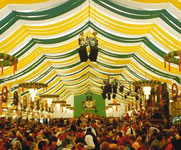
A warm welcome to the Bavarian and Upper Palatinate Forests, the home of the Crystal Road. Glassworkers here were creating works of art as long as 500 years ago, and they are still an important part of the local economy today. Glass from eastern Bavaria is highly sought after. Both utility glass by famous manufacturers and art glass pieces made in small workshops are in great demand all over the world. The Crystal Road runs for approximately 155 miles - 186 miles including subsidiary routes - from Neustadt an der Waldnaab, Europe's "lead crystal capital", to the Passau Glass Museum where over 15,000 examples of glassware from a range of different eras are on display. There is a great deal to see in this "glass kingdom" and many treasures to discover: rare and exquisite glass objects - some centuries old, some finished just a few minutes ago - in museums, galleries and glassworks. Quartz, lime, soda and potash are words that visitors will often hear in Bavaria, where glassblowing is a long and firmly established tradition.
The word "glass" is derived from the old German word for amber, and old Germanic jewelry was made almost exclusively of this fossilized resin. The Crystal Road allows visitors to encounter the glassmaking tradition at every turn and experience first-hand the international world of glass, its fascinating history and its universal appeal. The glassmaking process has remained essentially unchanged since the glassmaker's pipe was discovered some two thousand years ago. Glassblowers still fetch the red-hot, honey-like glass melt out of the furnace with their long "pipe", turning, swinging and blowing it to get the desired shape, as if by magic. Watch in fascination as these master craftsmen combine perfection with creativity as they mold their glass creations using the oven or working by their lamps. You can watch glassmakers at work at many show glassworks along the route. There are also any number of viewing tours, exhibitions and courses. Because the ancient craft of glassmaking cannot be replaced by machine, the mouth-blown tradition has been carefully preserved and is kept alive in many towns and villages.
 Skip to content
Skip to navigation
Skip to subnavigation
Skip to search
Skip to content
Skip to navigation
Skip to subnavigation
Skip to search







